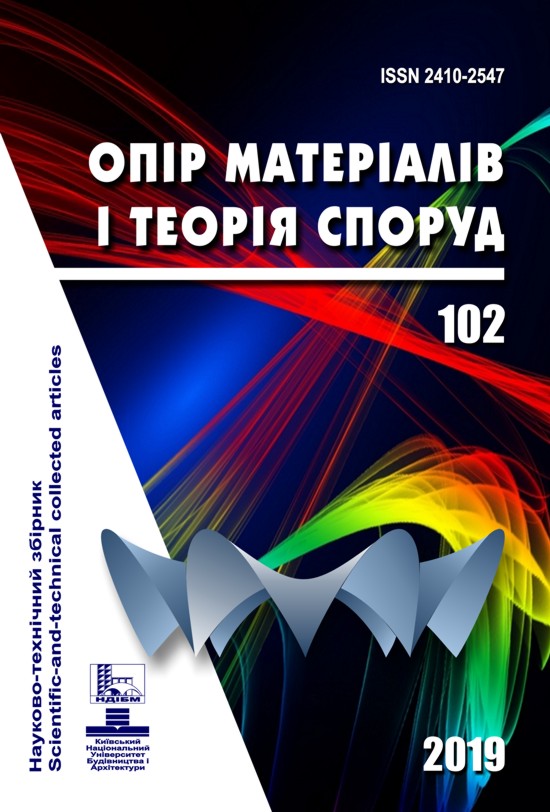Gas turbine impellers free vibration study using the fem analysis
DOI:
https://doi.org/10.32347/2410-2547.2019.102.69-76Keywords:
turbine rotor, impellers, free vibration, finite elements method, vibration modes and frequenciesAbstract
Due to the rather hard working process gas turbine engines rotor impellers are always heavily influenced by the unfavourable factors of the gas flow. So the close attention should be paid to the vibration processes in the rotor. More worse is the fact that the impeller consists of blades, which have a curvilinear geometric form. So they can’t be correctly described by the theory of plates or even by the plate finite elements. That’s why the problem can be solved only by the usage of space curvilinear finite elements on the base of which the mathematical model is built. The whole impeller can be considered as a cyclically symmetric system. Thus it can be divided into several sections, one of which would be studied. After the nonlinear FEM approximation of the aforementioned impeller’s section we receive a canonic matrix equation of the solid body vibration state. As in this study only the problem of the impeller free vibration is taken into consideration, than the matrix of damping and the vector of external forces are equal to zero. After making all necessary preparations, we find out the section free vibration modes and frequencies. All calculations were held for two types of boundary conditions that are chosen according to the impellers assembling schemes. Calculated results have been compared with the experimental data. As the divergence between them is less than 15%, than the developed mathematical model is adequate. The developed mathematical model and obtained results could be used for the gas turbine rotors forced vibration and stress-strain state study.
References
Samaras C. Emissions and lifetime estimation modeling of industrial gas turbines. / C. Samaras // M. Sc. Progress Review, Cranfield University, UK, 2009. P. 30–35.
Krishnakanth P. V. Structural and Thermal Analysis of Gas Turbine Blade by using FEM / P. V. Krishnakanth, G. Narasa Raju et. al. // International Journal of Scientific Research Engineering and Technology. 2013 Vol. 2, Issue 2. P. 060–065.
Mrinaline M. Steady state structural analysis of single crystal turbine blade / M. Mrinaline // International Journal of Engineering Research and Technology. 2016. Vol. V5, Issue 10. P. 382–384. doi: 10.17577/ijertv5is100314
Ugargol R. Life estimation of turbine blisk for a gas turbine engine / R. Ugargol, K. S. Narayanaswamy, C.V. Sesha Kumar // International Journal of Mechanical Engineering and Technology. 2017. Vol. 8, Issue 8. P. 393–399.
Rzadkowski R. Unsteady forces acting on the rotor blades in the turbine stage in 3D viscous flow in nominal and off-design regimes / R. Rzadkowski, V. Gnesin, L. Kolodyazhnaya // Journal of Vibration Engineering, and Technologies. 2014. Vol. 2, Issue 2. P. 89–95.
Baqersad J. Predicting full-field dynamic strain on a three-bladed wind turbine using three dimensional point tracking and expansion techniques / J. Baqersad, C. Niezrecki, P. Avitabile // Sensors and Smart Structures Technologies for Civil, Mechanical, and Aerospace Systems 2014. 2014. doi: 10.1117/12.2046106
Postnov V.V. Theoretical and experimental stress-strain analysis of machining gas turbine engine parts made of the high energy structural efficiency alloy / V. V. Postnov, S. V. Starovoitov, S. Yu. Fomin, R. R. Basharov // Journal of Engineering Science and Technology Review. 2014. Vol. 7, Issue 5. P. 47–50.
Bitkina O. Experimental and theoretical analysis of the stress–strain state of anisotropic multilayer composite panels for wind turbine blade / O. Bitkina, K.-W. Kang, J.-H. Lee // Renewable Energy. 2015. Vol. 79. P. 219–226. doi: 10.1016/j.renene.2014.11.004
Kostyuk A.G. Dinamika i prochnost’ turbomashin (Dynamics and strength of turbines) / A. G. Kostyuk // Moscow: Mashinostroenie, 1982. 264 p.
Vorobiev Yu.S. Kolebaniya lopatochnogo apparata turbomashin (Vibration of the turbine blades systems ) / Yu. S. Vorobiev // Kyiv: Naukova dumka, 1988. 224 p.
Sosunov V.A. Teoriya, raschet i proektirovanie aviacionnyh dvigateley i energeticheskih ustanovok (The theory, calculation and design of the aircraft engines) / V. A. Sosunov, V. M. Chepkin // Moscow: Mosk.energ. in-t., 2003. 677 p.
Pyhalov A.A. Staticheskiy i dinamicheskiy analiz sbornyh rotorov turbomashin (Static and dynamic analysis of the turbine rotors assemblies) / A. A. Pyhalov, A. E. Milov // Irkutsk: Izd-vo Irkut. tekhn. un-ta, 2007. 194 p.
Morgun S. The blades constructions finite elements models development / S. Morgun // Bulletin of the National Technical University «KhPI». Series: New Solutions in Modern Technologies. 2016. Issue 42 (1214). P. 86–91. doi: 10.20998/2413-4295.2016.42.14
Morhun S. The influence of the blade feather constructional inhomogeneity on the turbine cooling blades stress-strain state // Eastern-European Journal of Enterprise Technologies. Series: Applied Mechanics. 2018. Issue 2/7 (92). P. 11-17. DOI: 10.15587/1729-4061.2018.125937.
Downloads
Published
Issue
Section
License
Authors retain copyright and grant the journal right of first publication with the work simultaneously licensed under a Creative Commons Attribution License that allows others to share the work with an acknowledgement of the work's authorship and initial publication in this journal.

